This post contains affiliate links, which means I may earn a commission if you purchase through those links (at no extra cost to you).
I grew up making Orange Marmalade the old-fashioned way: soaking citrus overnight and boiling it rigorously to extract the natural pectin in the rind. When you follow my technique, you don’t need to add any store-bought pectin, and you get the best, cleanest-tasting marmalade.
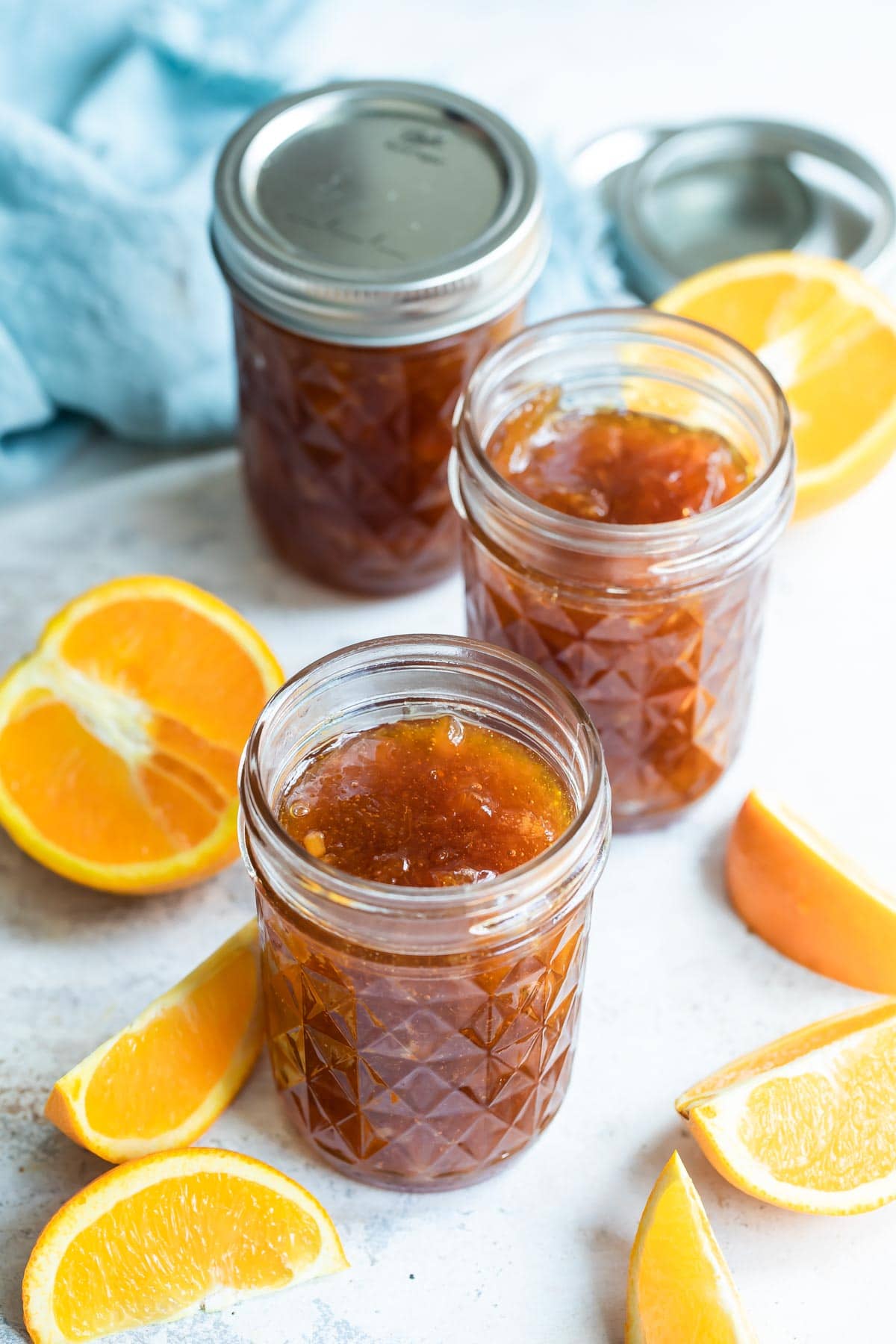
Nearly 1,000 5-star reviews prove this unfussy technique is simple and easy to follow. I also include my handy “cold plate test” so you can know for sure whether your marmalade is done or needs a little bit more time on the stove.
Home cooks everywhere are putting their abundant citrus to use to make their own homemade marmalade, and now you can, too. This recipe makes about 3 quarts total, or 12 (8 ounce jars). It freezes beautifully or you can process it in a water bath for canning.
Table of Contents
Marmalade Ingredients
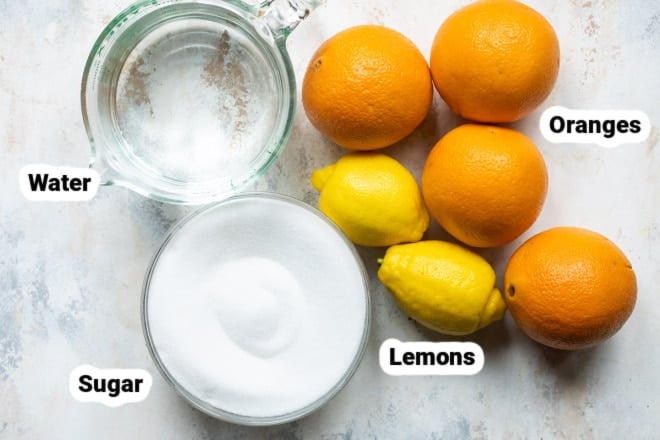
At a Glance: Here is a quick snapshot of what ingredients are in this recipe.
Please see the recipe card below for specific quantities.
- Oranges: This recipe is made with regular seedless oranges. You can definitely substitute Seville oranges if you can find them. They are only in season from the end of January to mid-February, but they have an intense flavor that is ideal for marmalade.
How to make Orange Marmalade
- Using a sharp knife, cut oranges and lemons in half crosswise, then into very thin half-moon slices. Discard any seeds. In a large pot (stainless steel), add the sliced oranges, lemons, and any fruit juice.
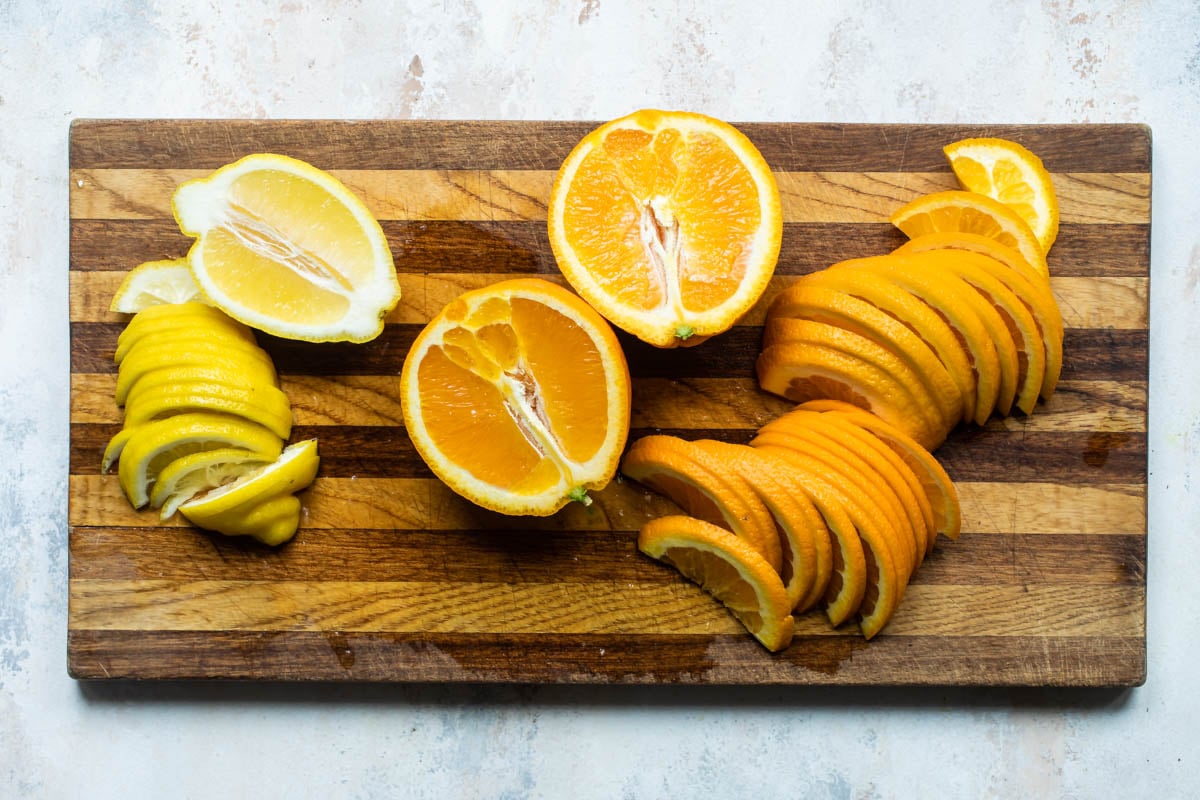
- Add water and bring the mixture to a boil over medium heat, stirring often. Remove from the heat and stir in the sugar until it dissolves. Cover and let stand overnight at room temperature.
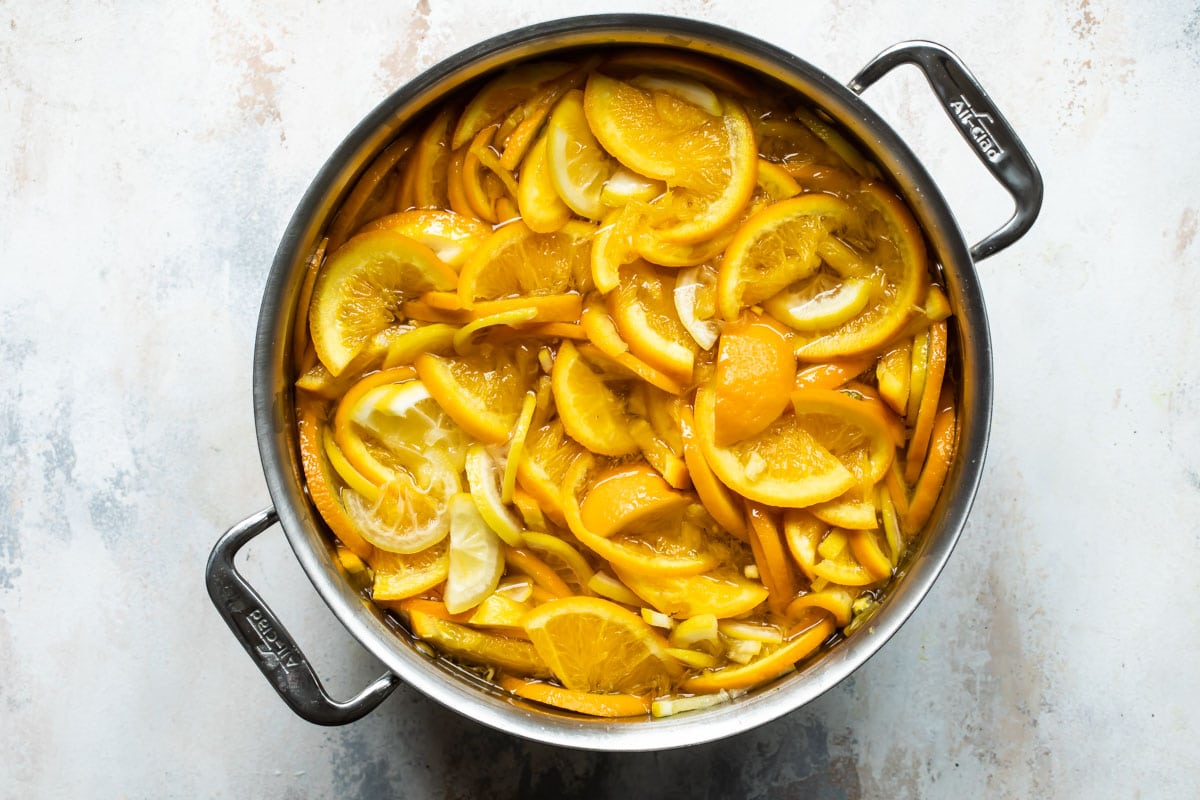
- The next day, bring the mixture back to a boil in the pot or saucepan. Reduce heat to low and simmer uncovered for 2 hours. Turn heat up to medium and boil gently, stirring often, for another 30 minutes. Skim off any foam that forms on the top. Cook until it reaches 220 degrees on a candy thermometer (you must hit this temperature for the natural pectin to gel with the sugar).
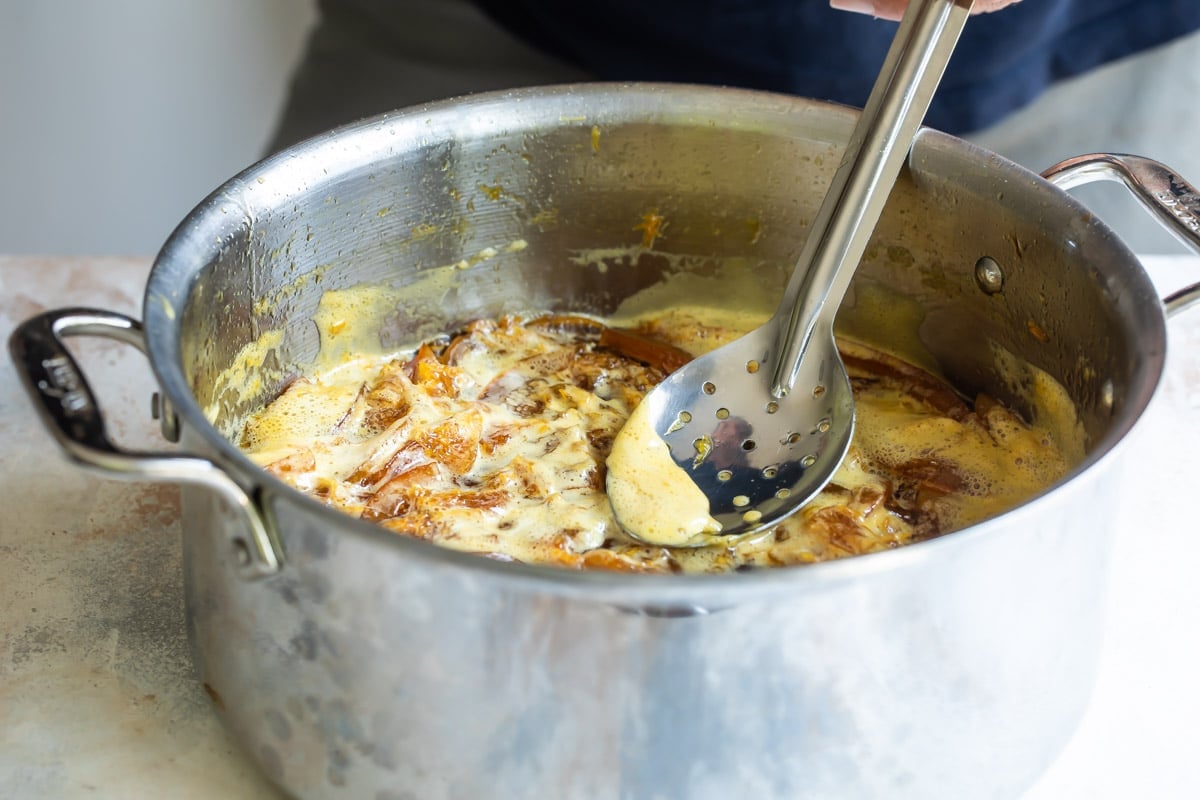
- To test if the marmalade is ready, place a small amount on a plate and refrigerate it until it’s cool but not cold. If it’s firm (neither runny nor hard), it’s ready. It will be a golden orange color. If it’s still runny, continue cooking it; if it’s hard, add a bit more water.
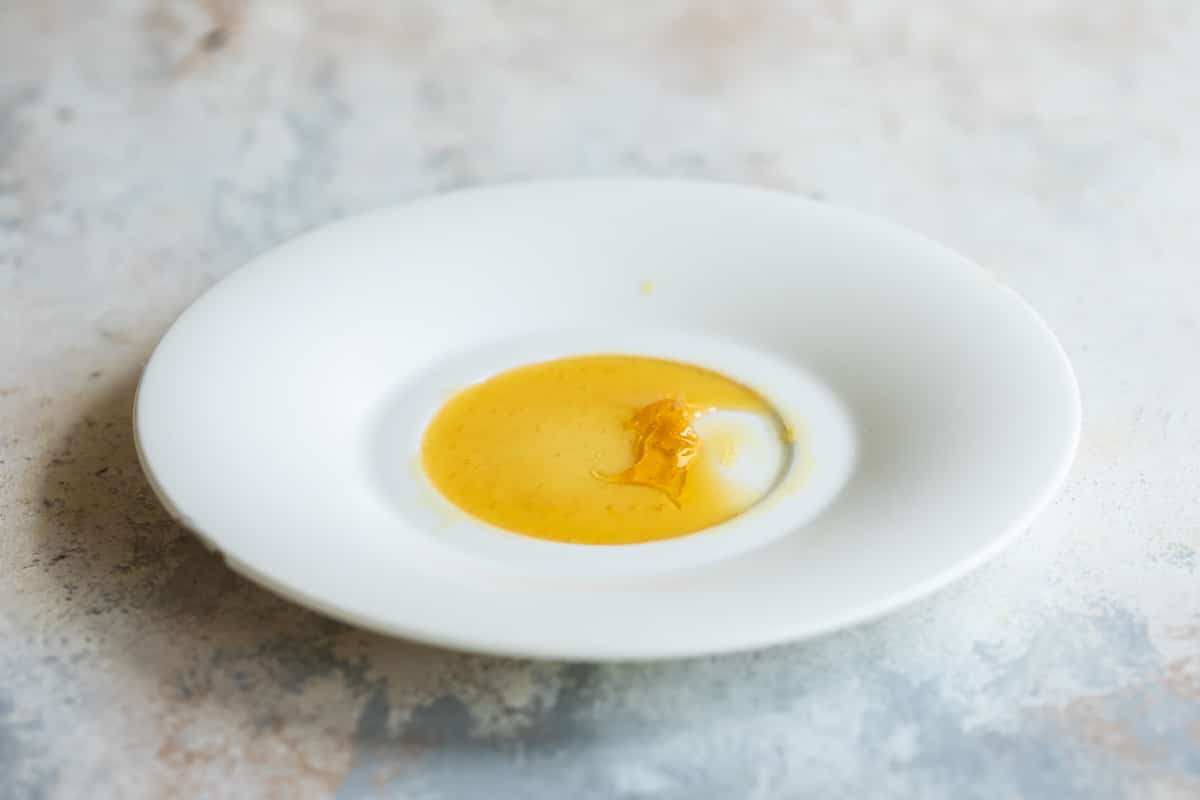
- Pour or ladle the marmalade into clean hot mason jars (I use this wide-mouth jar funnel for this recipe and so many others). Wipe the rims thoroughly with a clean damp paper towel, and seal with the lids. Chill in the refrigerator. It may take 24-48 hours for the natural pectin to set up properly.
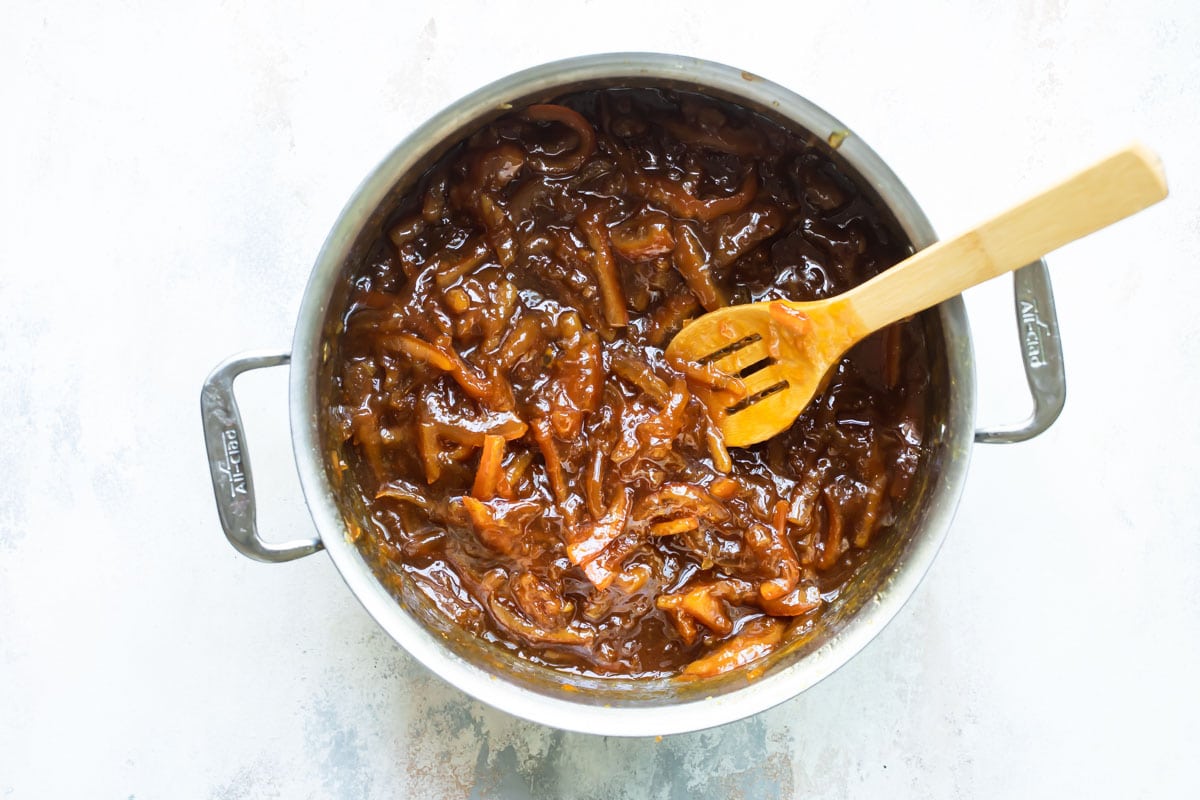
Orange Marmalade Recipe Variations
- Pectin: While many jam and jelly recipes require added pectin, you don’t need to add any here. Pectin is naturally concentrated in the pith of the orange (the bitter white part under the peel). This recipe coaxes out that natural pectin by letting the citrus soak overnight and then boiling it rapidly until enough water has evaporated that the mixture can reach 220 degrees.
- Agave nectar: Agave cannot penetrate and sweeten the peel as well as sugar can. When I tested it, the consistency was fine, but the rind tasted like raw rind. I don’t recommend this substitution.
- Low sugar: I haven’t tested low-sugar/alternative sweeteners in this recipe other than agave as listed above nor have I tweaked the amount of sugar in the recipe. I recommend seeking out recipes from experts in that area.
- Slow cooker: While it is technically possible to make marmalade in your slow cooker, it really depends on the power of your appliance. I no longer recommend that method because it isn’t reliable enough.
- Instant pot: Even with an overnight soak, the IP doesn’t break down the rind sufficiently. I don’t recommend this method.
Marmalade Recipe Tips
- Yield: This recipe makes about 3 quarts (96 ounces) of marmalade.
- If using 1/2-pint (8 ounce) jars, you’ll need 12.
- If using 1 pint (16 ounce) jars, you’ll need 6.
- If using the tiny jelly jars (4 ounce), you’ll need 24.
- Cold-plate test: To test if your marmalade is ready, spoon some hot marmalade on to a small plate and put it in the freezer to chill, or spoon some over an icy cold plate fresh from the freezer. If the mixture wrinkles slightly when you draw a spoon or finger across it, it has reached the setting point and is ready to go! If not, keep boiling and make sure the temperature reaches 220 degrees.
- Set-up time: Orange marmalade takes 24-48 hours for the natural pectin to set up completely. If it’s is still a little runny looking when it cools, check again in a day or two.
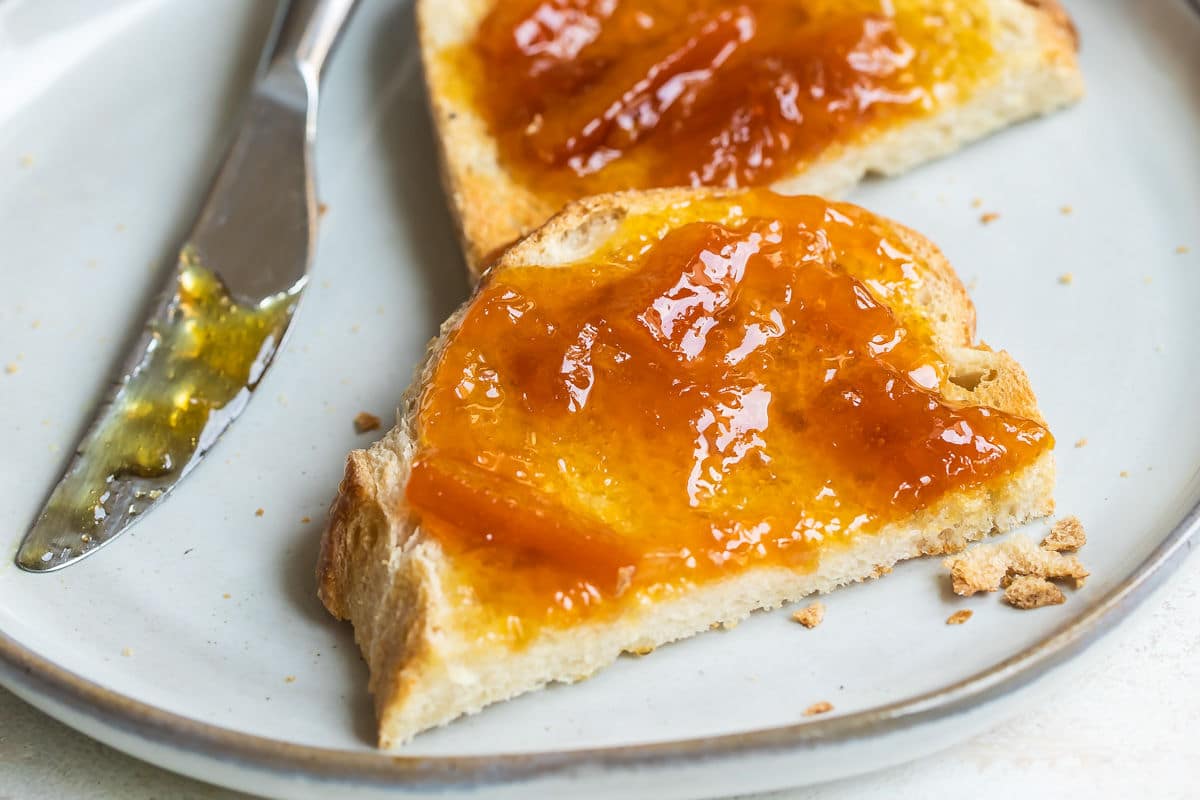
Storing and Canning Orange Marmalade
Storage: Store covered in the refrigerator for up to 1 month.
Freezer: Pack in freezer-safe containers or jars leaving 1/2-inch of headspace for expansion. Label, date, and freeze for up to 3 months. Thaw overnight in the refrigerator.
Canning: If putting up for storage, use a hot water or steam canner with a rack to properly seal lids on canning jars according to canning instructions. Otherwise, refrigerate and use within the month. Or, freeze for up to 3 months.
Frequently Asked Questions
Pectin is naturally concentrated in the pith of the orange (the bitter white part under the peel), so you don’t need to add any here. This recipe coaxes out that natural pectin by letting the citrus soak overnight and then boiling it rapidly until enough water has evaporated that the mixture can reach 220 degrees.
While it is technically possible to make marmalade in your slow cooker, it really depends on the power of your appliance. I no longer recommend that method because it isn’t reliable enough.
Even with an overnight soak, the IP doesn’t break down the rind sufficiently. I don’t recommend this method.
Agave cannot penetrate and sweeten the peel as well as sugar can. When I tested it, the consistency was fine, but the rind tasted like raw rind. I don’t recommend this substitution.
I don’t recommend making this recipe in a regular cast iron pan. It should be made in a non-reactive pan. Enameled cast iron, stainless steel, and non-stick are best and will not affect the color or taste of the marmalade
More fruit recipes
Pie and Tart Recipes
Fresh Fruit Tart
Fruit Dessert Recipes
Apple Crisp with Oatmeal
Cake Recipes
Lemon Bundt Cake Recipe
Muffins and Quick Breads
Banana Muffins
Join Us

Orange Marmalade
Equipment
- Jar funnel (for wide mouth jars)
Ingredients
- 4 large seedless oranges scrubbed clean (about 3 pounds or 8 cups slices, see note 1)
- 2 lemons (about ½ pound or 1 cup slices)
- 8 cups water
- 8 cups granulated sugar
Instructions
- Cut oranges and lemons in half crosswise, then into very thin half-moon slices. Discard any seeds. In a large stainless steel pot, add the sliced oranges, lemons, and any accumulated juices.
- Add water and bring the mixture to a boil, stirring often. Remove from the heat and stir in the sugar until it dissolves. Cover and let stand overnight at room temperature.
- The next day, bring the mixture back to a boil. Reduce heat to low and simmer uncovered for 2 hours. Turn heat up to medium and boil gently, stirring often, for another 30 minutes.
- Skim off any foam that forms on the top. Cook the marmalade until it reaches 220 degrees (you must hit this temperature for the natural pectin to gel with the sugar).
- To test if the marmalade is ready, place a small amount on a plate and refrigerate it until it's cool but not cold (see note 4). If it's firm (neither runny nor hard), it's ready. It will be a golden orange color. If the marmalade is runny, continue cooking it; if it's hard, add a bit more water.
- Pour the marmalade into clean hot mason jars; wipe the rims thoroughly with a clean damp paper towel, and seal with the lids. Chill in the refrigerator. It may take 24-48 hours for the natural pectin to set up properly.
Recipe Video
Notes
- Oranges: This recipe is made with regular seedless oranges. You can definitely substitute Seville oranges if you can find them. They are only in season from the end of January to mid-February, but they have an intense flavor that is ideal for marmalade.
- Yield: This recipe makes about 3 quarts (96 ounces) of marmalade.
- If using 1/2-pint (8 ounce) jars, you’ll need 12.
- If using 1 pint (16 ounce) jars, you’ll need 6.
- If using the tiny jelly jars (4 ounce), you’ll need 24.
- Storage: Store covered in the refrigerator for up to 1 month.
- Cold-plate test: To test if your marmalade is ready, spoon some hot marmalade on to a plate and put it in the freezer to chill, or spoon some over an icy cold plate fresh from the freezer. If the mixture wrinkles slightly when you draw a spoon or finger across it, it has reached the setting point and is ready to go! If not, keep boiling and make sure the temperature reaches 220 degrees.




I started out great; was on step 4 then fell in the kitchen and required at trip to the hospital. After 5+ hours there, I was sent home and told I needed bed rest and elevate my leg and foot. So my marmalade got an extra 12 hour additional wait I finished up. What a terrific recipe to forgiving to my unexpected medical problems and still come out just right.
Hi Kate, wow you really had me going in the first half! I was visualizing you falling because you slipped on marmalade or something. Glad everything is okay. Stay safe out there! -Meggan
Hallo Meggan,
just trying ot your recipe. How do I turn 220 on a gas burner?
Hi Towela! Sorry for the confusion. You cannot set a temperature on a burner like that. You need to use a thermometer to monitor the temperature and see when it gets to 220 degrees. It takes a while because you have to cook off enough water to raise the temperature above the boiling point (212 degrees). I hope this helps! Thanks. -Meggan
Excellent recipe, I am mad about marmalade and this is by far the easiest recipe and yet the best result I’ve had! I’m making it for the second time now. First time was with Navel oranges but Seville are now in their very short season (August in Australia) and trying it with the them. This time I’ve switched the lemons for an additional 2 Oranges since I love the extra peel and thought that Seville would give me the bitterness without the lemon. Also, I make my peel quite chunky, which is more of a British style.
BTW I thought that any Bourbon drinkers might enjoy a creative way to use your marmalade. I discovered that it goes really well in an Old Fashioned believe it or not! Since you’re putting sugar and orange into your Bourbon anyway, try it with a spoonful of marmalade. Just add Bitters and ice. Delicious
Hi Terry, you’re just my favorite. I love the idea of adding Bourbon AND using it in an old fashioned! So creative! I am going to try making sandwich cookies with marmalade closer to the holidays. And, I keep experimenting with an “orange marmalade” granola. I haven’t figured it out yet, but it seems like it would be a great idea. So I just have to keep trying. Thank you so much for your creativity and for trying my recipe. I’m so grateful. Take care! -Meggan
Absolutely delicious! Used Seville oranges and followed recipe to a tee.
Thank you a definite winner!
Hi Meggan,
Your recipe says to use a stainless steel pot. Can I use an enameled pot?
Looking forward to making this recipe once I’m out of self-isolation.
Hi Esther, yes, you should be fine. I don’t know why I wrote that? I think it just needs to be a non-reactive pot. Not aluminum, not cast-iron. Enameled should be fine. Thanks! -Meggan
Hi Meggan, loved your recipe. Had been given alot of oranges from a friends tree and found your recipe online while searching for ways to use them. Have now made your easy peasy marmalade several times for family and friends to also enjoy. They all want more! Have found a way to cut down on the amount of peel in it (dont really want that much on my toast!). Firstly cut it fine to start with but also use a stick blender to reduce the amount. I still make sure I leave some there though so that it “looks” like marmalade. Thanks and stay safe.
Can I use lime instead of lemon?
Also, I want to make spicy with jalapenos but not sure when to add them? I was thinking when I turn up heat to 220.
Hi Jess! Lime works just as well, the peel might be a little more noticeable but that’s it. My friends in Mexico have made this with limes because they rarely have lemons there. As to when to add the jalapenos (sounds like a fantastic idea honestly), I think when you turn it to up to 220 also. That sounds like a good time. I’d love to hear how it works out, if you end up doing it, and if you feel like reporting back. Take care! Thanks. -Meggan
You say to slice the oranges and lemons thinly. Could I use the slicing disk of my food processor, or perhaps my mandolin slicer; or do you think that the slices would be too thin?
Hi Paulette, I don’t think the slices could ever be “too thin.” The thinner the better. I just don’t know that a mandolin or food processor could cut through rind like that. I have tried a mandolin myself – it didn’t work. It’s just awkward. A food processor, well, I just don’t really see it working but maybe I’m wrong? I could see a commercial maybe working, but I mean like something a grocery store deli would have, not anything a home cook would have. You are welcome to try but I’d hate to have anything happen to your food processor. Thanks! -Meggan
Dear Meggan,
Your recipe is a lot easier than the old way. With COVID-19, the local food banks have been giving out fruit boxes weekly and included are oranges. Just heard we’re back on stay-home orders so I figured this was the time to make Marmalade. Your recipe sounded a lot easier so I gave it a try. Drove my neighbors crazy with the perfume of marmalade and now they keep coming hoping to snag a jar.I’m nevering buying it again. Thanks for the wonderful recipe. Stay safe and keep on cooking.
Can I substitute the lemons for more oranges and some lemon juice?
Hi Kaity, I don’t see a problem at all with that, should be just fine! Thanks. -Meggan